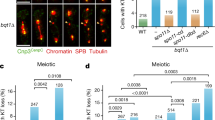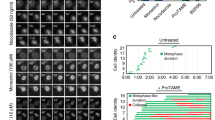Abstract
During meiosis, two rounds of chromosome segregation occur after a single round of DNA replication, producing haploid progeny from diploid progenitors. Three innovations in chromosome behaviour during meiosis I accomplish this unique division. First, crossovers between maternal and paternal sister chromatids (detected cytologically as chiasmata) bind replicated maternal and paternal chromosomes together. Second, sister kinetochores attach to microtubules from the same pole (mono-polar orientation), causing maternal and paternal centromere pairs (and not sister chromatids) to be separated. Third, sister chromatid cohesion near centromeres is preserved at anaphase I when cohesion along chromosome arms is destroyed. The finding that destruction of mitotic cohesion is regulated by Polo-like kinases1,2 prompted us to investigate the meiotic role of the yeast Polo-like kinase Cdc5. We show here that cells lacking Cdc5 synapse homologues and initiate recombination normally, but fail to efficiently resolve recombination intermediates as crossovers. They also fail to properly localize the Lrs4 (ref. 3) and Mam1 (ref. 4) monopolin proteins, resulting in bipolar orientation of sister kinetochores. Cdc5 is thus required both for the formation of chiasmata and for cosegregation of sister centromeres at meiosis I.
This is a preview of subscription content, access via your institution
Access options
Subscribe to this journal
Receive 12 print issues and online access
$209.00 per year
only $17.42 per issue
Buy this article
- Purchase on Springer Link
- Instant access to full article PDF
Prices may be subject to local taxes which are calculated during checkout




Similar content being viewed by others
References
Alexandru, G., Uhlmann, F., Mechtler, K., Poupart, M.A. & Nasmyth, K. Phosphorylation of the cohesin subunit Scc1 by Polo/Cdc5 kinase regulates sister chromatid separation in yeast. Cell 105, 459–472 (2001).
Sumara, I. et al. The dissociation of cohesin from chromosomes in prophase is regulated by Polo-like kinase. Mol. Cell 9, 515–525 (2002).
Rabitsch, K.P. et al. Kinetochore recruitment of two nucleolar proteins is required for homolog segregation in meiosis I. Dev. Cell 4, 535–548 (2003).
Toth, A. et al. Functional genomics identifies monopolin: a kinetochore protein required for segregation of homologs during meiosis I. Cell 103, 1155–1168 (2000).
Chu, S. et al. The transcriptional program of sporulation in budding yeast. Science 282, 699–705 (1998).
Hepworth, S.R., Friesen, H. & Segall, J. NDT80 and the meiotic recombination checkpoint regulate expression of middle sporulation-specific genes in Saccharomyces cerevisiae. Mol. Cell. Biol. 18, 5750–5761 (1998).
Klein, F. et al. A central role for cohesins in sister chromatid cohesion, formation of axial elements, and recombination during yeast meiosis. Cell 98, 91–103 (1999).
Salah, S.M. & Nasmyth, K. Destruction of the securin Pds1p occurs at the onset of anaphase during both meiotic divisions in yeast. Chromosoma 109, 27–34 (2000).
Sym, M., Engebrecht, J.A. & Roeder, G.S. ZIP1 is a synaptonemal complex protein required for meiotic chromosome synapsis. Cell 72, 365–378 (1993).
Buonomo, S.B. et al. Disjunction of homologous chromosomes in meiosis I depends on proteolytic cleavage of the meiotic cohesin Rec8 by separin. Cell 103, 387–398 (2000).
Uhlmann, F., Wernic, D., Poupart, M.A., Koonin, E.V. & Nasmyth, K. Cleavage of cohesin by the CD clan protease separin triggers anaphase in yeast. Cell 103, 375–386 (2000).
Tanaka, T., Fuchs, J., Loidl, J. & Nasmyth, K. Cohesin ensures bipolar attachment of microtubules to sister centromeres and resists their precocious separation. Nat. Cell Biol. 2, 492–499 (2000).
Aris J.P. & Blobel, G. Identification and characterization of a yeast nucleolar protein that is similar to a rat liver nucleolar protein. J. Cell Biol. 107, 17–31 (1988).
Hunter, N. & Kleckner, N. The single-end invasion: an asymmetric intermediate at the double-strand break to double-Holliday junction transition of meiotic recombination. Cell 106, 59–70 (2001).
Allers, T. & Lichten, M. Intermediates of yeast meiotic recombination contain heteroduplex DNA. Mol. Cell 8, 225–231 (2001).
Keeney, S., Giroux, C.N. & Kleckner, N. Meiosis-specific DNA double-strand breaks are catalyzed by Spo11, a member of a widely conserved protein family. Cell 88, 375–384 (1997)
Cao, L., Alani, E. & Kleckner, N. A pathway for generation and processing of double-strand breaks during meiotic recombination in S. cerevisiae. Cell 61, 1089–1101 (1990).
Allers, T. & Lichten, M. Differential timing and control of noncrossover and crossover formation during meiosis. Cell 106, 47–57 (2001).
Shirayama, M., Zachariae, W., Ciosk, R. & Nasmyth, K. The Polo-like kinase Cdc5p and the WD-repeat protein Cdc20p/fizzy are regulators and substrates of the anaphase promoting complex in Saccharomyces cerevisiae. EMBO J. 17, 1336–1349 (1998).
Stegmeier, F., Visintin, R. & Amon, A. Separase, polo kinase, the kinetochore protein Slk19, and Spo12 function in a network that controls Cdc14 localization during early anaphase. Cell 108, 207–220 (2002).
Evan, G.I., Lewis, G.K., Ramsay, G. & Bishop, J.M. Isolation of monoclonal antibodies specific for human c-Myc proto-oncogene product. Mol. Cell. Biol. 5, 3610–3616 (1985).
Piatti, S., Bohm, T., Cocker, J.H., Diffley, J.F. & Nasmyth, K. Activation of S-phase-promoting CDKs in late G1 defines a “point of no return” after which Cdc6 synthesis cannot promote DNA replication in yeast. Genes Dev. 10, 1516–1531 (1996).
Nairz, K. & Klein, F. mre11S – a yeast mutation that blocks double-strand-break processing and permits nonhomologous synapsis in meiosis. Genes Dev. 11, 2271–2290 (1997).
Loidl, J., Klein, F. & EnD gebrecht, J. in Nuclear structure and function (ed. M. Berrios) 257–285 (Academic Press, San Diego, 1998).
Acknowledgements
We thank the Nasmyth group and F. Klein, S. Hauf, M. Winey and N. Hunter for discussions, F.Klein for help with chromosome spreads, H. Tkadletz for help preparing figures, and K. Rabitsch and D. Schoffnegger for promoter replacement reagents. We thank A. Amon and B. Lee for communicating unpublished results and providing the Pclb2-CDC20 strain. R.K.C. was sponsored by the Damon Runyon Cancer Research Foundation. Research in the Nasmyth laboratory is supported by Boehringer Ingelheim International and the Austrian Industrial Research Promotion Fund.
Author information
Authors and Affiliations
Corresponding author
Ethics declarations
Competing interests
The authors declare no competing financial interests.
Supplementary information
Supplementary Figures
Figure S1. Rec8 chromatin association and homologue synapsis during pachytene. (PDF 89 kb)
Figure S2. A Cdc5-dependent form of Rec8 accumulates in metaphase I.
Supplementary Table
Table 1. Genotypes of strains described in this study. (DOC 26 kb)
Rights and permissions
About this article
Cite this article
Clyne, R., Katis, V., Jessop, L. et al. Polo-like kinase Cdc5 promotes chiasmata formation and cosegregation of sister centromeres at meiosis I. Nat Cell Biol 5, 480–485 (2003). https://doi.org/10.1038/ncb977
Received:
Accepted:
Published:
Issue Date:
DOI: https://doi.org/10.1038/ncb977
This article is cited by
-
Construction of strains to identify novel factors for regulation of centromeric cohesion protection (CCP) and sister kinetochore mono-orientation (SKM)
BMC Molecular and Cell Biology (2019)
-
The molecular basis of monopolin recruitment to the kinetochore
Chromosoma (2019)
-
An interplay between Shugoshin and Spo13 for centromeric cohesin protection and sister kinetochore mono-orientation during meiosis I in Saccharomyces cerevisiae
Current Genetics (2018)
-
PP2ACdc55’s role in reductional chromosome segregation during achiasmate meiosis in budding yeast is independent of its FEAR function
Scientific Reports (2016)
-
Generation of an inducible system to express polo-like kinase, Cdc5 as TAP fusion protein during meiosis in Saccharomyces cerevisiae
3 Biotech (2016)



